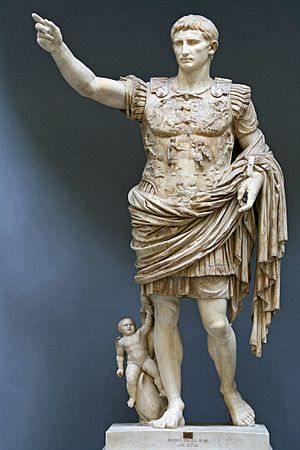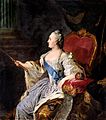Emperor facts for kids

An emperor is a male ruler who leads an empire. An empire is a large group of lands and people controlled by one powerful leader. Emperors often come to power when a parent or relative who was also an emperor passes away. In some countries, people would choose a new emperor from different candidates. The wife of an emperor is called an Empress. Sometimes, a woman who rules an empire on her own is also called an empress, like Catherine the Great.
Today, the only emperor in the world is the Emperor of Japan (called tennō). However, he has very little power. The real leaders of Japan are the Diet (their parliament) and the Prime Minister. This is because Japan is a constitutional monarchy, where the monarch's power is limited by a constitution.
What is an Emperor?
The English word "emperor" comes from the Latin word imperator. Latin was the language of the old Roman Empire. At first, an imperator was a very strong general (an army leader). But after Augustus became the first Roman Emperor, the title was only used for the most powerful rulers.
Many countries throughout history have had leaders called "emperor" in English. For example, the leaders of the Byzantine Empire in Greece were called basileus or autokrator. The leaders of the Holy Roman Empire in Germany were called imperator or Kaiser. The rulers of the Ottoman Empire in Turkey were known as sultan, padishah, khagan, or kaysar. All these rulers often saw themselves as new parts of the old Roman Empire.
Emperors Around the World
Leaders of other countries who claimed to rule the whole world or called themselves "king of kings" are also often called emperors in English.
- The old rulers of China were called huangdi.
- The leaders of Russia were known as tsars.
- The rulers of Ethiopia were called negusa negast.
There have also been emperors in other countries:
For a while, the rulers of the United Kingdom also called themselves the emperors and empresses of India.
Related pages
Images for kids
-
A statue of dictator Julius Caesar.
-
This famous mosaic shows the Byzantine emperor Justinian I in Ravenna.
-
Holy Roman Emperor Charles V in the 1550s.
-
One of the most famous imperial coronations was when Napoleon crowned himself Emperor in Paris.
-
George V, King of the United Kingdom and Emperor of India.
-
Wilhelm II, German Emperor and King of Prussia.
-
Empress of Russia Catherine the Great.
-
Emperor of Serbia Dušan the Mighty.
-
Agostino Veneziano's picture of Ottoman emperor Suleiman the Magnificent.
-
Emperor Moctezuma II of the Aztec Empire.
-
Pedro II, Emperor of Brazil.
-
Portrait of Maximilian I of Mexico.
-
Haile Selassie, Emperor of Ethiopia from 1930 to 1974.
-
Emperor Hirohito, the last Japanese Emperor who ruled with full powers (photographed 1926).
-
Emperor Gojong of the Korean Empire.
-
Genghis Khan was the first Emperor of the largest land empire in history, the Mongol Empire.
-
Bảo Đại, the last Emperor of Vietnam.
See also
 In Spanish: Emperador para niños
In Spanish: Emperador para niños





















